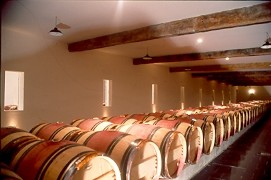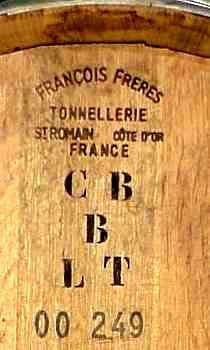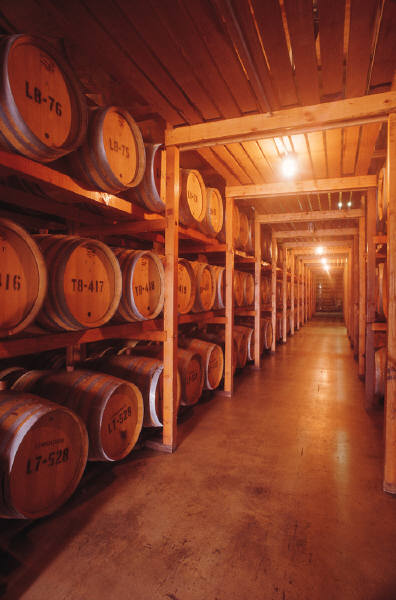|
Wine
Barrels
|
| |
|
.The
use of wine barrels (especially oak barrels) to store
and age wine is a centuries old tradition (and solution). Wine
aged in oak barrels is enhanced with the addition of vanilla and
oak overtones. Wooden Wine Barrels also allow for a small amount
of evaporation of the contents during the aging period.
|

Wine
Barrels in the Chai at Chateau Canon |
French
Oak was considered especially desirable wood for making wine barrels
for many years. Most French Oak comes from one or more of the forests
that were planted in the days of Napoleon for shipbuilding. Since
the days of sailing ships have come and gone, those French forests
have become ongoing forestry operations. Five primary forests used
for wine barrel production are Allier, Limousin, Nevers, Trancais
and Vosges. Each of these forests produces wood with distinctive
characteristics involving tightness of the wood grain as well as
the amount of oak flavors that are imparted to the wine. Tight grained
wood tends to impart the Oak characteristics (vanilla, spice and
butter flavors) much more slowly than wood with looser grain. Winemakers
select wood for their wine barrels from different forests for the
effect on the finished wine.
|
Early
experiments with American Oak (and that of many other countries)
were not very successful since the amount of influence that the
barrel had on the taste of the wine was too great. At first it
was thought that the problem was with the wood itself. Now we
know that most of the difficulties were caused by the way the
wood was prepared and the way the barrel was constructed. As coopers
began using traditional French barrelmaking techniques on 'foreign'
oak, the results improved dramatically.
|
L
T is for Light Toast |
Perhaps
the two most significant differences in wood preparation and barrel
construction techniques were the seasoning of the wood and the
way the staves were prepared. The French Coopers always let the
wood air-dry for at least 24 months to attain proper seasoning.
The American barrel makers were more used to building whiskey
barrels and used a kiln-dry method to season the wood. The staves
for whiskey barrels were also sawn rather than split. The French
barrel makers split the wood along the grain of the wood to make
the staves. Splitting rather than sawing produced staves (and
ultimately barrels) that had more subtle effects on the wine.
|
Once the
French barrel building techniques were applied to Oak from other
countries, the results improved substantially. It is now common
to find American Oak as well as that of several other countries
including Hungary in the construction of wine barrels. Barrels
made from American Oak typically cost less than half the price
of French Oak Barrels and are now capable of achieving similar
results.
|
|
During
the construction of the barrel, a step takes place where the partially
assembled barrel is placed over a small wood fire. During this
step, the inside of the barrel is charred or 'toasted'. The amount
(depth) of char in the barrel has an effect on the wine that is
aged in it. Winemakers can normally order their barrels with Light
Toast, Medium Toast or Heavy Toast. The 'toast' decision will
be made based on the grape variety to be used in the barrel as
well as the style of wine to be produced.
|
There
are a wide variety of additional options available to the winemaker
when it comes to wine barrels. Many winemaking regions have traditional
shapes (i.e. - Bordeaux
Barrels vs. Burgundy
Barrels). There are also many sizes of barrels as well as variations
in the thickness of the staves and the way the barrels are finally
constructed.
|
It is
most common for wines to be fermented in temperature-controlled
Stainless Steel tanks before they are placed in oak barrels for
aging. Some grape
varieties, such as Chardonnay
and Pinot
Noir, may be fermented and aged in the same Oak barrel.
Since new barrels impart more flavors to the wine than previously
used barrels, the percentage of new barrels used by a winery each
year is an important piece of information. By the time a barrel
is about 5 years old, it is virtually neutral as far as its influence
on the taste of the wine.
|
Various
techniques have been developed to extend the use of barrels or
to gain the benefits of oak aging without actually going to the
time or expense of the traditional methods. One method involves
shaving the inside of used barrels and inserting new thin inner
staves that are toasted. Another procedure is to use oak shavings
in a large 'tea bag' that is placed inside stainless steel tanks
of wine. None of these cost saving techniques has been able to
achieve the results of traditional barrel aging.
|


